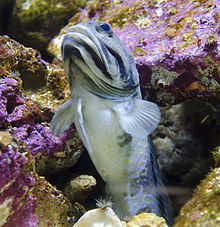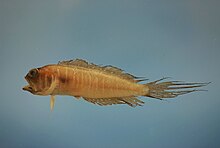Pine fish
| Pine fish | ||||||||||||
|---|---|---|---|---|---|---|---|---|---|---|---|---|

Goldstirn-Brunnenbauer ( Opistognathus aurifrons ) |
||||||||||||
| Systematics | ||||||||||||
|
||||||||||||
| Scientific name | ||||||||||||
| Opistognathidae | ||||||||||||
| Swainson , 1839 | ||||||||||||
The family of the pine fish (Opistognathidae), also known as fountain builders , belongs to the group of perch relatives (Percomorphaceae) and comprises four genera with over 80 species . The fish got their German names because of their large mouths or because of their vertical living corridors in the sea floor.
features
They are large-headed and loud-mouthed fish with a laterally flattened, elongated body covered with small cycloid scales of white, gray or dirty yellow in color. The sides of the head are usually flaky. The mouth is large, in some species the maxillary reaches almost to the gill cover . The head is scaly with a steep forehead, the large, oval eyes are set far in front. There are a number of small teeth along the edge of the jaw, one or more more may be further back. The palatine bone is toothless. The dorsal fin extends from the neck to the tail fin base and has nine to twelve mostly flexible fin spines and 12 to 22 segmented soft rays. There is often a slight indentation between the hard and soft part. The anal fin is also long, with two to three slender spines and 10 to 21 segmented rays. The pelvic fins stand in front of the pectoral fins and have a spine and five segmented soft rays. The inner three are weak, small and branched, the outer two unbranched and stronger. The caudal fin is rounded and is supported by 12 to 14 branched fin rays. The sideline is high, just below the dorsal fin, is incomplete and ends below the center of the dorsal fin. Your pores are usually embedded in the skin. Well builders are three to fifty centimeters long. Most species remain under a length of twelve centimeters. The species of the genus Stalix are only 2.2 to 6 centimeters long. When it comes to body color, different brown tones are usually predominant. There is often a black spot under the hard-nosed part of the dorsal fin.
distribution
Pine fish are found in the tropical Atlantic and Indo-Pacific , particularly species-rich in the Gulf of California and on the Pacific coast of Central America from Mexico to Panama .
behavior
Pine fish live in shallow water, usually no deeper than 30 meters, on open sandy or scree bottoms in which they build their vertical living passages. Some species have also been caught at depths of up to 200 meters. The inner walls of the caves are attached with the help of stones, pieces of coral , mussel shells or other things. Most species often live in small colonies in small areas, some others are solitary. The caves are only left for short distances to get food or to defend the territory. The rest of the day the fish remain in the burrow with their heads looking out. Threatened by a potential predator, they disappear tail first into their burrow. All jawfish are protogynous hermaphrodites that change sex from female to male in the course of their life. To mate, the male lures a female into his tube. The males of all jawfish are mouthbrooders . The young fish hatch after eight to nine days in the best-researched Goldstirn well-builder , which has already been bred in aquariums . The eggs stuck together in a clump with filaments are laid to mend the living tube and to feed. They feed on zooplankton and fry, which they prey a few centimeters above their tube swimming freely.
Systematics
Pine fish are closely related to the tortoiseshell (Gobiesocidae) and the slime fish- like (Blennioidei) and, with both taxa, form the superordinate order of the Blenniimorphae in the latest revision of the bony fish systematics.
Genera and species
There are about eighty described and many undescribed species in four genera:



-
Anoptoplacus Smith-Vaniz, 2017
- Anoptoplacus pygmaeus Smith-Vaniz, 2017
-
Lonchopisthus Gill, 1862
- Lonchopisthus ancistrus Smith-Vaniz & Walsh, 2017
- Lonchopisthus higmani Mead, 1959
- Lonchopisthus lemur (Myers, 1935)
- Lonchopisthus micrognathus ( Poey , 1860)
- Lonchopisthus sinuscalifornicus Castro-Aguirre & Villavicencio-Garayzar, 1988
-
Opistognathus Cuvier, 1816
- Opistognathus adelus Smith-Vaniz, 2010
- Opistognathus afer Smith-Vaniz, 2010
- Opistognathus albicaudatus Smith-Vaniz, 2011
- Opistognathus alleni Smith-Vaniz, 2004
- Gold-fronted fountain builder ( Opistognathus aurifrons ) ( Jordan & Thompson, 1905)
- Opistognathus brasiliensis Smith-Vaniz, 1997
- Opistognathus brochus Bussing & Lavenberg, 2003
- Opistognathus castelnaui Bleeker , 1860
- Opistognathus crassus Smith-Vaniz, 2010
- Opistognathus cuvierii Valenciennes , 1836
- Opistognathus cyanospilotus Smith-Vaniz, 2009
- Opistognathus darwiniensis (Macleay, 1878)
- Opistognathus decorus Smith-Vaniz & Yoshino, 1985
- Dickkopf well builder ( Opistognathus dendriticus ) (Jordan & Richardson , 1908)
- Opistognathus dipharus Smith-Vaniz, 2010
- Opistognathus elizabethensis Smith-Vaniz, 2004
- Opistognathus ensiferus Smith-Vaniz, 2016
- Opistognathus evermanni (Jordan & Snyder, 1902)
- Opistognathus eximius ( Ogilby , 1908)
- Opistognathus fenmutis Acero P. & Franke, 1993
- Opistognathus fossoris Bussing & Lavenberg, 2003
- Opistognathus galapagensis Allen & Robertson, 1991
- Opistognathus gilberti Böhlke, 1967
- Opistognathus hongkongiensis (Chan, 1968)
- Opistognathus hopkinsi ( Jordan & Snyder, 1902)
- Opistognathus inornatus (Ramsay & Ogilby, 1887)
- Opistognathus iyonis (Jordan & Thompson, 1913)
- Marble jawfish ( Opistognathus jacksoniensis ) (Macleay, 1881)
- Spotted jawfish ( Opistognathus latitabundus ) (Whitley, 1937)
- Opistognathus leprocarus Smith-Vaniz, 1997
- Opistognathus liturus Smith-Vaniz & Yoshino, 1985
- Opistognathus lonchurus (Jordan & Gilbert, 1882)
- Opistognathus longinaris Smith-Vaniz, 2010
- Banded jawfish ( Opistognathus macrognathus ) ( Poey , 1860)
- Opistognathus macrolepis (Peters, 1866)
- Opistognathus margaretae Smith-Vaniz, 1984
- Opistognathus maxillosus (Poey, 1860)
- Opistognathus megalepis Smith-Vaniz, 1972
- Opistognathus melachasme Smith-Vaniz, 1972
- Opistognathus mexicanus Allen & Robertson, 1991
- Muscat well builder ( Opistognathus muscatensis ) ( Boulenger , 1887)
- Opistognathus nigromarginatus Rüppell , 1830
- Opistognathus nothus Smith-Vaniz, 1997
- Opistognathus panamaensis Allen & Robertson, 1991
- Papuan well builder ( Opistognathus papuensis ) ( Bleeker , 1868)
- Opistognathus pardus Smith-Vaniz, Bineesh & Akhilesh, 2012
- Finely spotted jawfish ( Opistognathus punctatus ) (Peters, 1869)
- Opistognathus randalli Smith-Vaniz, 2009
- Opistognathus reticeps Smith-Vaniz, 2004
- Opistognathus reticulatus (McKay, 1969)
- Opistognathus rhomaleus (Jordan & Gilbert, 1882)
- Opistognathus robinsi Smith-Vaniz, 1997
- Opistognathus rosenbergii Bleeker, 1857
- Blue-spotted jawfish ( Opistognathus rosenblatti ) Allen & Robertson, 1991
- Opistognathus rufilineatus Smith-Vaniz & Allen, 2007
- Opistognathus schrieri Smith-Vaniz, 2017
- Porthole jawfish ( Opistognathus scops ) (Jenkins & Evermann, 1889)
- Opistognathus seminudus Smith-Vaniz, 2004
- Opistognathus signatus Smith-Vaniz, 1997
- Opistognathus simus Smith-Vaniz, 2010
- Opistognathus smithvanizi Bussing & Lavenberg, 2003
- Opistognathus solorensis Bleeker, 1853
- Opistognathus stigmosus Smith-Vaniz, 2004
- Opistognathus thionyi Smith-Vaniz et al., 2018
- Opistognathus trimaculatus Hiramatsu & Endo, 2013
- Opistognathus variabilis Smith-Vaniz, 2009
- Opistognathus verecundus Smith-Vaniz, 2004
- Opistognathus vicinus Smith-Vaniz et al., 2018
- Opistognathus walkeri Bussing & Lavenberg, 2003
- Opistognathus whitehursti (Longley, 1927)
-
Stalix Jordan & Snyder, 1902
- Stalix davidsheni Klausewitz, 1985
- Stalix dicra Smith-Vaniz, 1989
- Stalix eremia Smith-Vaniz, 1989
- Stalix flavida Smith-Vaniz, 1989
- Stalix histrio Jordan & Snyder, 1902
- Stalix immaculata Xu & Zhan, 1980
- Stalix moenensis (Popta, 1922)
- Stalix novikovi Prokofiev, 2015
- Stalix omanensis Norman, 1939
- Stalix sheni Smith-Vaniz, 1989
- Stalix toyoshio Shinohara, 1999
- Stalix versluysi (Weber, 1913)
Aquarium keeping
Some species of pine fish, especially the gold-forehead well builder from the Caribbean , are kept in saltwater aquariums. You need high (more than 10 centimeters), not too fine substrates in order to be able to build your living tube. Pine fish only accept food that drifts in the water near their living tube. If the feed sinks to the ground, it is no longer considered. Therefore, they cannot be kept together with larger fish that snatch food away from them. The Goldstirn-Brunnenbauer is commercially grown in fish farms for aquarium purposes.
literature
- Joseph S. Nelson : Fishes of the World. Wiley, New York 2006, ISBN 0-471-25031-7 .
- Kurt Fiedler: Fish. Fischer, Jena 1991, ISBN 3-334-00339-6 ( textbook of special zoology. Volume 2, part 2).
- Hans A. Baensch , Helmut Debelius , Horst Moosleitner: Sea water atlas. Volume 1, Mergus, Melle 1997, ISBN 3-88244-110-0 .
- Rudie H. Kuiter , Helmut Debelius: Atlas of the marine fish. Kosmos, Stuttgart 2006, ISBN 3-440-09562-2 .
- Ewald Lieske, RF Myers: Coral fish of the world. Year, Hamburg 1994, ISBN 3-86132-112-2 .
- Dieter Eichler, Robert F. Myers: Coral fish. Central Indo-Pacific. Year, Hamburg 1997, ISBN 3-86132-225-0 .
Individual evidence
- ↑ Ricardo Betancur-R, Edward O. Wiley, Gloria Arratia, Arturo Acero, Nicolas Bailly, Masaki Miya, Guillaume Lecointre and Guillermo Ortí: Phylogenetic classification of bony fishes . BMC Evolutionary Biology, BMC series - July 2017, DOI: 10.1186 / s12862-017-0958-3
Web links
- Pine fish on Fishbase.org (English)






